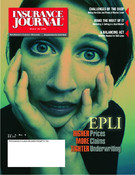|
Unless you’ve been hiding under a rock somewhere for the past year or two, yes, we’re in the midst of a hardening market cycle. After a prolonged soft market period, prices seem to be firming in every segment, with drastic changes in classes experiencing the most exposure and poorest results. In the executive liability arena, the best example of this is Directors & Officers (D&O) liability for publicly traded companies, where many insurers are grappling with improving their results.
Return to underwriting
I’ve heard this phrase used a great deal over the past 12 months. The context is always the same—a suggestion that the market as a whole had stopped scrutinizing the business that it took in, and now realizes that it must return to underwriting in order to improve results. One must confess how humorous this concept is: if “underwriter” is the name of the profession, how could one stray so far from the concept of underwriting as to necessitate “returning” to it?
There does finally seem to be a growing realization in the market that underwriting is not simply individual risk selection. There once was a perception that underwriting was an “art.” It is instead a science that can be performed artfully. Achieving an underwriting profit requires things such as an understanding of the cost of capital deployed to support the business, accurate pricing and reserve assumptions, underwriting/risk selection discipline, reliable management information to evaluate results and the unwavering resolve to make changes that are needed to sustain profitability. Without all of these, an insurer is ill equipped to sustain itself through all of the phases in a market cycle. This isn’t just an important goal for returning value to the shareholders of the insurer, but also for providing reliable capacity to policyholders, as well as agents and brokers.
The perfect storm
What a great book, and the movie was really pretty good too if you saw it on the big screen. Over the past year I’ve heard this phrase uttered countless times to describe how the market got into its current predicament with D&O. The expansion of coverage to include entity securities coverage, broadened terms and inadequate pricing, combined with a significant increase in claim severity and frequency of severity, has been likened to the meteorological events so dramatically bearing this name. Sounds dramatic—as if preordained and even tragically unavoidable. Notably, it also attempts to shift the blame for the poor results to something beyond our mortal control. Just not true.
For years the profitability of this line has been in question. Even as the coverage expansions were first being thrown around there were some companies that opted out of this market, having analyzed the exposure and potential actuarial Armageddon and decided to use their capacity elsewhere. Even as the storm began to expand on the horizon, many denied it saying “we’re making money,” actually saying it often enough to believe it themselves. Perhaps the best example ever of something people treated as an art, forgetting the science.
Public D&O: A 4-letter word
True, results have been poor in the public D&O arena. However, it has been the expansion of coverage, inadequate price charged for the product and, interestingly, particular segments of this business that have driven the profit woes. The most significant of these has been the provision of entity securities coverage, transferring the D&O protection originally designed to entice talented people to serve on corporate boards into a type of balance sheet protection for the corporation.
Public D&O is not a 4-letter word and, contrary to reports, the patient isn’t dead—but it does require massive surgery. This coverage plays an important role in supporting the public trust. We want corporate boards of public companies to be staffed by the smartest, most honest and honorable people we can get. Those people will not serve on public boards if their homes, children’s education and retirement plans are at risk. That’s why it’s essential that we as an industry provide solutions to this problem. “A-side” coverage is available, designed to protect directors and officers when the corporation cannot indemnify them for their liability. There are also enhanced products which combine A-side protection with some additional coverages, such as “difference in conditions coverage.” These products, and others like them that will likely be developed in the coming year, are the answer to the public D&O dilemma.
Whatever the current challenges, the insurance market is cyclical and subject to the same economic pressures of the business world at large. Insurers that embrace some of the concepts I’ve discussed will be better suited to ride out all phases of the cycle. Clients, agents and brokers should continue to consider—and place even greater emphasis upon—their insurance provider’s attitude on the issues raised here and their ultimate ability to survive the storm.
Jeffrey Klenk is the senior vice president responsible for Executive Liability fo the Bond division of Travelers Property Casualty.
Topics Windstorm Underwriting
Was this article valuable?
Here are more articles you may enjoy.



 Soccer Officials Arrested After Melee That Damaged Hard Rock Stadium in Miami
Soccer Officials Arrested After Melee That Damaged Hard Rock Stadium in Miami  Insurers Face Business Interruption Claims After Global Tech Outage
Insurers Face Business Interruption Claims After Global Tech Outage  Project 2025 Plan to End NFIP Welcomed by Some, Rejected by Others in Insurance
Project 2025 Plan to End NFIP Welcomed by Some, Rejected by Others in Insurance  Progressive Q2 Net Income Skyrockets Over 320%
Progressive Q2 Net Income Skyrockets Over 320% 


